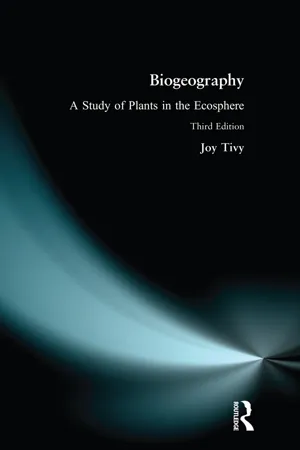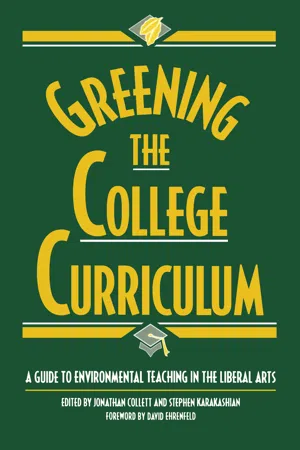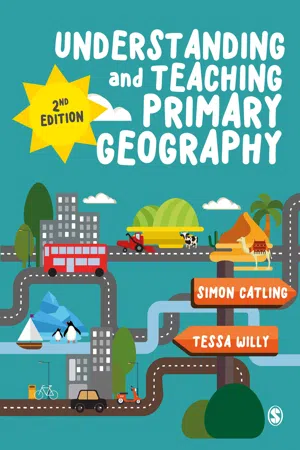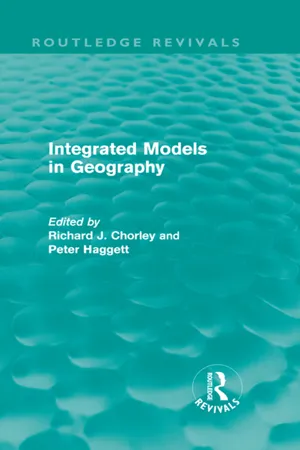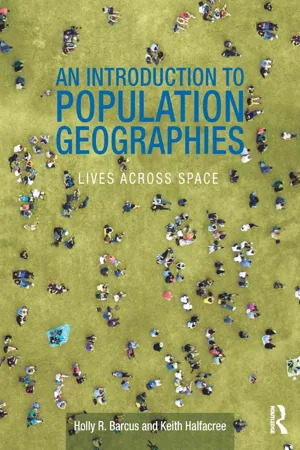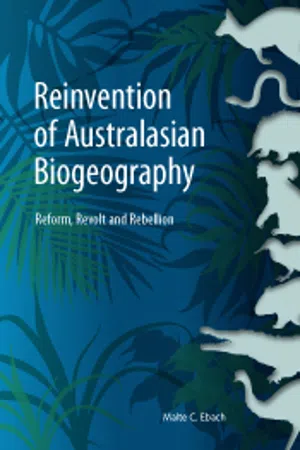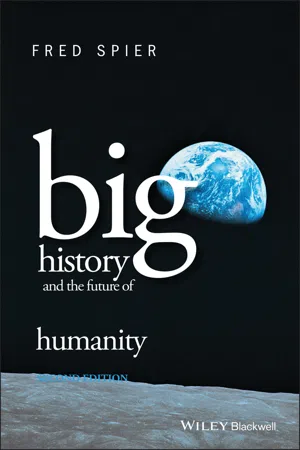Geography
Life on Earth
"Life on Earth" refers to the diverse range of living organisms that inhabit the planet, including plants, animals, and microorganisms. It encompasses the interactions between these organisms and their physical environment, as well as the processes that sustain life, such as photosynthesis and respiration. Understanding the distribution and characteristics of life on Earth is a key focus of geographic study.
Written by Perlego with AI-assistance
Related key terms
7 Key excerpts on "Life on Earth"
- eBook - ePub
Biogeography
A Study of Plants in the Ecosphere
- Joy Tivy(Author)
- 2018(Publication Date)
- Routledge(Publisher)
_______ Chapter _______1Introduction
Biogeography, as the term indicates, is both a biological and a geographical science. Its ‘field of study’ is the biologically inhabited part of the lithosphere, atmosphere and hydrosphere – or, as it has become known – the biosphere . Its subject-matter covers the multitudinous forms of plant and animal life which inhabit this relatively shallow but densely populated zone, as well as the complex biological processes which control their activities. The approach to, and aim of, the subject is geographical in so far as it is primarily concerned with the distribution (together with the causes and implications thereof) of organisms and biological processes. However, although this ‘field of study’ is shared by, and is common to, both biology and geography it is not the exclusive preserve of either of these two sciences. By its very character, biogeography is situated at, and overlaps the boundaries of, a great number of other disciplines. The geologist, climatologist, pedologist, geomorphologist as well as the botanist, zoologist, geneticist and geographer (to mention but a few) all ‘cultivate’ or ‘crop’ as the case may be, particular parts of this very large and varied field; and in doing so they are, to a greater or lesser extent, essential to, as well as being dependent on, an understanding of biogeography. As a result, the approach to – or concept of – biogeography is in large measure determined by the training, interest and objectives of the particular student.The geographer’s interest tends to focus on (to be organised around) the spatial variation of two basic characteristics or processes, rather than on any particular components of the biosphere. The first is the intimate interrelationship between the organic and inorganic elements of the earth’s environment; the character of the biosphere is primarily a product of the continual interaction or interchange between the lithosphere and the atmosphere. The second is the reciprocal relationship between humans and the biosphere. On the one hand the latter provides the vital link between man and his physical environment; and despite the advances of modern science and technology man is still, whether he realises or likes it, completely dependent on the biosphere for his food. On the other hand, because of an ability, greater than that possessed by any other form of life, to exploit organic resources he is not only an integral part of the biosphere but is now the ecologically dominant organism in it. The significance of biogeography is particularly well expressed by the ecologist M.G. Lemée (1967: 4) in Précis de Biogégraphie - eBook - ePub
Greening the College Curriculum
A Guide To Environmental Teaching In The Liberal Arts
- Jonathan Collett, Stephen Karakashian(Authors)
- 2013(Publication Date)
- Island Press(Publisher)
The approach of geographers to the study of environmental change emphasizes spatial pattern, a large scale of inquiry (over space and time), and the integration of social and natural sciences. Geographers typically conduct research at the level of landscape or region; for example, considering land use patterns and their impact on vegetation in a drainage basin or watershed. Recently, geographers have begun working at much broader scales. Such a study is under way in Mexico, where Liverman (1990) is investigating the capacity of small-scale farmers to cope with climatic change over several decades. Research elsewhere documents local adaptation in land management upon elevated exposure to storms, oil spills, flooding, and other forms of environmental risk (Kates and Burton 1986).While geography as a discipline encompasses a broad realm of inquiry, geographers as individuals tend to specialize in either human or physical studies, often borrowing methods of analysis from other disciplines. Geographers traditionally break the study of human transformation of the biosphere into four fields: (1) regional studies, (2) people—environ-ment studies, (3) environmental processes and resources, and (4) spatial analysis.Regional Studies
Geographers working in this tradition address conservation issues relevant to a particular place. A regional focus allows students to understand how the physical characteristics and social history of a place have led to a unique land use system. Students may draw on this insight to evaluate the sustainability of a land use system and to predict how changing external and internal factors may result in the transformation or degradation of a landscape (Leighly 1969). For example, many Latin Americanist geographers examine how deforestation in the Amazon is driven by distinctive regional characteristics such as land tenure patterns, demographic features, government policies, and agricultural and economic systems (Hecht and Cockburn 1989; Smith 1982).People—Environment Studies
Within this broad focus, geographers explore the relationship between society and nature in terms of causes and consequences. The justification for environmental conservation is likely to vary dramatically according to a society’s own view of its relationship with nature. Ancient writers such as Hippocrates, Ptolemy, and Strabo expressed a profound desire to define the human role in the natural world. Since then, many philosophies have developed, ranging from the Christian doctrine of defining man as master of nature (Glacken 1956) (see Chapter 11, Religion), to Romantic/Arcadian ideas of humanity in harmony with nature (O’Riordan 1981) (see Chapter 7, Literature), to deterministic theories akin to social Darwinism that individual and social characteristics are formed by the physical environment (Semple 1911), to notions that human choice is influenced primarily by cultural and historical factors (Lewthwaite 1966). (These latter viewpoints are discussed fully in Chapter 2, Anthropology.) Accordingly, the aim of conservation will vary in terms of what type of human intervention in ecosystems a given society considers desirable. - eBook - ePub
- Simon Catling, Tessa Willy(Authors)
- 2018(Publication Date)
- SAGE Publications Ltd(Publisher)
Physical and human geography appear all around us and are important in our daily lives. The natural world provides us with a wide range of resources that provide the raw materials for bricks, stone, concrete, tiles, wood and glass for buildings, as well as the sources of the metals, plastics and energy from which we manufacture materials and generate electricity. Our mobile phones depend for their materials on the natural environment, but they are also the result of human ingenuity, from design to component manufacture and to sales, supported by the sites of aerials to enable us to keep in touch with each other and with the variety of websites we access. Understanding how our food is grown, the nature and quality of the soil, what optimal agricultural conditions are for different crops and animal husbandry, how food is processed before it reaches us and then the energy we use for cooking, require and integrate many aspects of physical and human geography in describing and explaining what happens, why and with what effect for ourselves and others. Physical and human geographies are key to understanding our everyday lives, just as much as in helping us know about and appreciating the nature, events and activities of the wider world. These two interrelated aspects of geography matter a great deal to us all.Environmental geography
Geographers have always recognised that physical and human geography are inextricably linked and highly dependent upon one another in a dynamic and constantly evolving way. They effect, change and impact on each other continuously and so, within geography, cannot realistically be seen separately, although research on particular topics may give this impression. This interface has been termed environmental geography (Castree et al., 2009), and at times an holistic or unified approach in geography, to describe both the processes and the impact of each aspect on the other (Matthews and Herbert, 2004, 2008). This is indicated in Figure 6.1 . Topics that might be included in environmental geography include climate change and deforestation as well as land reclamation and conservation.An understanding of environmental geography is crucial if we are to appreciate the complexity of the interrelationship of human geography and physical geography and how we can live in a sustainable way on the Earth. While it is important to understand the specific processes in physical and human geography, we also need to help children appreciate the interplay between them, and how that impacts on people’s lives and the physical environment in which we live. This can be exemplified through two examples.Figure 6.1 Aspects of physical and human geography and their interface with environmental geographyWhen building a dam to create a reservoir to provide water for settlements, it is crucial to understand the local geology and geomorphology in order to select the best valley site. In the case of a dam built in Andalucía in Spain, the engineers did not appreciate that they were building a dam in a limestone environment and could not understand why it never filled up. The water appeared as a waterfall where the rock type changed over 10km away and the dam became a white elephant and could never be used – it remains there today. Understanding the local geology is fundamental, just as it is essential to know that building a dam directly affects those who live and use the land in the chosen valley site, who will need to be moved out, as well as those who live downstream from the reservoir. It will be essential to do everything to mitigate negative impacts. - Richard Chorley, Peter Haggett(Authors)
- 2013(Publication Date)
- Routledge(Publisher)
Chapter Thirteen Organism and Ecosystem as Geographical Models D. R. Stoddart IntroductionGeography and ecology are concerned with the distribution, organization and morphology of phenomena on the surface of the earth (Slobodkin, 1962, p. 78), and both disciplines have developed similar concepts and techniques to handle similar problems (Bunge, 1964, pp. 3–4). Overt geographical interest in ecological techniques, however, has been largely confined to a small group of biogeographers, whose influence on the rest of the subject has been marginal, and to a group of American sociologists who sought for a time to restate the aims of human geography in terms of human ecology.The influence of biological concepts in geography, however, has been both deeper and more pervasive than explicit reference might suggest. Thus, in spite of current insistence on the importance of areal differentiation as a methodological framework for geography, derived by Hartshorne from the work of von Richthofen and Hettner, much geographical work in the past hundred years has taken its inspiration directly from Darwin and the biological revolution which he began. Elsewhere I have indicated some of the main strands in the evolutionary impact on geographical thought since 1859: particularly the emphasis on changing form through time, expressed in organic analogies of ageing; the popularity of natural selection and environmental models, particularly in early American human geography; and, latterly, the application of Haeckel’s concept of ecology and Tansley’s of the ecosystem, which may be traced back to the third chapter of The Origin of Species (Stoddart, 1966).This essay treats the biological impact on a methodological level. In Kuhn’s (1962) terminology, we are concerned with the evolution of geographic paradigms of largely biological inspiration: paradigms, or interrelated networks of concepts on a sufficiently general level which serve to define, at least for a time, the nature of geographical goals and the conventional frameworks within which these are pursued. The paradigms examined here are those of organism and ecosystem- eBook - ePub
An Introduction to Population Geographies
Lives Across Space
- Holly R. Barcus, Keith Halfacree(Authors)
- 2017(Publication Date)
- Routledge(Publisher)
And finally but critically, these circumstances are, to greater or lesser degrees, ever-changing through a life, through their embodiment in a life course (Chapter 2). In short, life experiences are always relational in respect of spaces and individual lives. Understanding and explaining the population geographies of births, deaths and population movement requires taking into account a wide array of economic, social, cultural, political and environmental processes. These are reflected in, for example, resource conflict, everyday living environments, differences in health and well-being, levels of poverty and inequality, and relationships formed both within and between peoples and countries. These processes both shape the population characteristics of any particular society and its individual members, and are in turn shaped by them. Thus, studying Population Geography requires core demographic indicators such as births, deaths and migrations not to be thought of in isolation but examined through their entanglements with the full panoply of diverse processes that construct everyday life. This is, of course, no mean feat but reflects both the challenge and potential sense of achievement to be had in explaining what the present authors are calling lives across space. Next, though, an historical account of Population Geography up to the present day is outlined. This both establishes a fuller academic context for the rest of the book and demonstrates how an expanded notion of Population Geography is congruent with recent critical reflection within the sub-discipline. Table 1.1 Comparative infant mortality rates Infant mortality - eBook - ePub
Reinvention of Australasian Biogeography
Reform, Revolt and Rebellion
- Malte C. Ebach(Author)
- 2017(Publication Date)
- CSIRO PUBLISHING(Publisher)
3 In order to understand what biogeography is, we need to see how biogeography is done.The search for natural biotic areas
Unless you are reading this in outer space, you are currently in – or driving, riding, flying or sailing over – a natural biogeographic region. The region is defined by the organisms that inhabit it – the biota – which have been formed by millions of years of evolutionary, geographical, geological and climatic processes. This includes the barriers that encapsulate the biota, isolating it from other biota. Over time, these biota diversify and become endemic to areas in which they live. If you are standing in a plain near a troop of kangaroos, for example, you are most likely in Australia. But things get moved around. For instance, you may also be standing in a kangaroo enclosure in a zoo. Biogeography is never clear cut; rather it is messy. Animal and plants tend to move around, either naturally or by human-assisted means, such as the introduction of the cane toad in Australia or eucalypts in Spain. Identifying which organisms are part of a natural area is incredibly difficult for several reasons. First, not many people work on more than one taxonomic group. A single taxonomic group does not make a biota. Next is the problem of whether your taxonomic group is actually endemic. It might be introduced or naturally cosmopolitan. The biggest hurdle, however, is determining the relationships between the species and genera under study. Without these, you have no independent source of information about the relationships of your areas. The only way to find out what these relationships are is to find the relationships between the morphological or molecular characteristics of your organisms. For much of the 18th, 19th and 20th centuries, this type of information was unavailable. Not until the 1970s were we able to investigate morphological and genetic relationships using numerical methods. Before then, natural areas were assumed, and never tested, given the lack of an analytical method. Without confirmation of natural areas, much biogeography was descriptive; that is, limited to describing and naming areas. There was, and still is, a dominant component to biogeography – the narrative. Knowing the origins and distributional history of species and their genera has been a mainstay of biogeographers since Linnaeus. Narratives about taxic distribution over time, such as dispersal routes for migrations and extinctions, provide a natural history of the organisms in question. Narration is not descriptive or analytical, nor does it necessarily require a method. Over time, our narratives were synthesised in the conclusions to many taxonomic monographs and phylogenetic studies. Biogeography was nothing more than assuming natural biotic areas and telling stories about the distributional histories of its organisms. That is until 1978, when Donn Eric Rosen, an American ichthyologist at the American Museum of Natural History, made a significant breakthrough in how we find the relationships between biotic areas (Rosen 1978). That breakthrough was a result of a new way of doing biological classification – cladistics – and it completely reformed traditional Linnaean taxonomy. - eBook - ePub
- Fred Spier(Author)
- 2015(Publication Date)
- Wiley-Blackwell(Publisher)
−4 watt/kg today. As a result, most of what follows here cannot yet be expressed in numbers.The Gaia Hypothesis
When life began to develop on Earth, inanimate and biological nature increasingly influenced each other. The first pioneering studies of these interactions were performed in the early twentieth century by Russian scientist Vladimir Ivanovich Vernadsky (1863–1945 CE ), who elaborated the idea of the ‘biosphere,’ a term coined by Austrian geologist Eduard Suess (1831–1914 CE ). But only since the 1980s CE have biologists and geologists worldwide begun to explore this idea systematically. In science, this approach is now known as ‘System Earth.’15The impact of early life on the Earth’s surface and atmosphere must have been rather limited. Yet as life developed, it became increasingly influential. This happened in a series of waves. The first wave took place perhaps as long ago as 2 billion years, when the first free oxygen appeared in the atmosphere that was produced by life. The second wave occurred around 540 million years ago, when complex life forms proliferated. The third wave happened from about 400 million years ago, when complex life moved onto land. Ever since that time, all geological processes on the surface of the entire Earth were affected by life. It would, for instance, have facilitated the erosion of rocks by ‘eating’ them, or by keeping loose soil together with the aid of microbial mats. These are just a few examples of the influence life has exerted on the Earth’s surface. Surprisingly, perhaps, life may even have influenced plate tectonics. Surface water, possibly kept on Earth by life, may have lubricated the moving plates, thus making plate tectonics possible. Our planet’s deeper interior, by contrast, would have remained the exclusive domain of inanimate processes undisturbed by life.
Learn about this page
Index pages curate the most relevant extracts from our library of academic textbooks. They’ve been created using an in-house natural language model (NLM), each adding context and meaning to key research topics.
